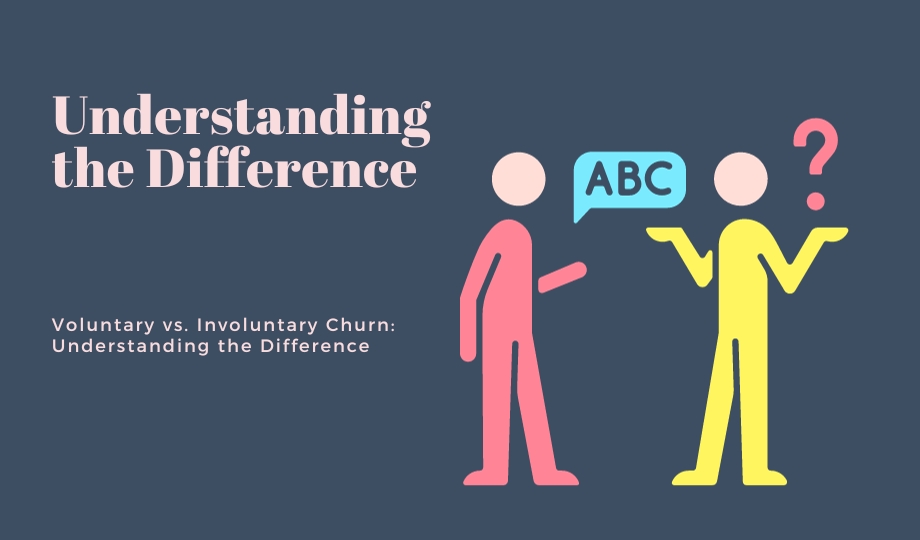In the business world, the reality is that customers come and go, no matter how exceptional your product or service may be. To effectively manage customer attrition, whether controllable or not, you need to grasp the concept of churn. Customer influx and outflow, collectively known as churn, hold significant implications for your business, especially in subscription-based models where retention is a competitive edge.
Understanding Voluntary vs. Involuntary Churn:
Churn can be classified into voluntary and involuntary categories. To differentiate between these two facets, let’s delve deeper into their components:
Voluntary Churn: Occurs when a customer consciously cancels a brand’s products or services due to various reasons like dissatisfaction, competition, poor service, or product-related issues.
Involuntary Churn: Takes place when a customer’s subscription transaction fails due to issues like delayed payments, insufficient funds, server errors, or outdated payment details, regardless of the customer’s intention to continue the subscription.
Current Landscape on Involuntary Churn:
In the evolving post-pandemic landscape, the subscription market is undergoing significant changes driven by shifting consumer buying and usage patterns. Involuntary churn remains a substantial threat to companies operating in the subscription-based service market. According to research conducted by PYMNTS and FlexPay, 27% of subscribers terminate their subscriptions due to payment declines. With the proliferation of new service providers worldwide, the competition in the subscription market is intensifying.
Calculating Your Business’s Churn Rate:
To prevent customer attrition, it’s essential to calculate your churn rate. Two significant calculations can provide insights into the churning process:
Customer Churn Rate: This is the ratio of customers lost to the number of customers at the beginning of a period, usually expressed as a percentage.
Customer Churn = [(Customers at the beginning of a period) – (Customers at the end of that period)] / (Customers at the beginning of that given period)
Revenue Churn Rate: Offers a more comprehensive view of your revenue statistics, including Gross Revenue Churn and Net Revenue Churn.
Gross Revenue Churn Rate: Measures total revenue loss through customer cancellations and downgrades, excluding revenue expansion and upgrades.
Gross Revenue Churn Rate = [(Downgrade MRR + Cancellation MRR) / (Total MRR at the beginning of the period)] * 100
Net Revenue Churn Rate: Reflects the actual revenue change, accounting for losses and gains.
Net Revenue Churn Rate = [(MRR beginning of the month – MRR end of the month) – (Expansion MRR)] / (MRR beginning of the month) * 100
Top Reasons for Involuntary Churns:
Several factors contribute to involuntary churn, including:
Payment Failure Due to Card Expiry: Approximately 14% of card transaction failures result from expired card details, causing automatic subscription renewals to fail.
Insufficient Funds: Customers may lack sufficient funds in their accounts, particularly towards the end of the billing cycle, leading to payment failures.
Not Charging Funds as Recurring Payments: Failing to categorize payments as recurring may trigger card company suspicions, resulting in blocked transactions.
Credit Card Limits: Transactions can fail if credit card limits are exceeded, set either by the issuing company or the customer.
No Dunning Strategies: Overlooking communication regarding near-expiry dates and potential payment issues can lead to increased transaction failures.
Causes of Voluntary Churns & How to Address Them:
Several reasons contribute to voluntary churn within a customer’s lifecycle:
Unmet Customer Needs: Customers cancel subscriptions when they feel a product or service no longer aligns with their requirements. Seeking regular feedback and acting on it can help tailor offerings to customer needs.
Misalignment Between Brand and Audience: Targeting the wrong demographic can lead to voluntary churn. Ensure that your product offerings match your target audience’s preferences and financial capacity.
Offer Pause Options: Allow customers to pause subscriptions rather than forcing them to cancel entirely, enhancing loyalty and customer flexibility.
How to Reduce Involuntary Churns:
Addressing involuntary churn can be achieved through several strategies:
Card Expiry Email Reminder: Regularly remind customers of impending card expiry to maintain a connection, retain customers, and ensure uninterrupted subscriptions.
Payment Reminders via Email: Send payment reminders to customers even for recurring subscriptions to prevent billing disputes.
Pre-Dunning Banner Notifications: Use pre-dunning banners and notifications to keep customers informed of upcoming payments, ensuring satisfaction and reducing involuntary churn.
Post-Dunning Email: Send post-dunning emails to acknowledge payment collection and communicate any payment issues or changes to customers.
Offer Grace Period: Provide a grace period for customers to address payment issues before considering their subscription as inactive.
In Conclusion:
Regardless of the type of churn affecting your business, losing customers for any reason can have adverse effects on your revenue. Prioritizing customer retention through comprehensive strategies is a cost-effective approach that can prove more beneficial than acquiring new customers.

